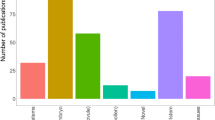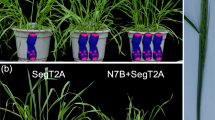Abstract
Meiosis is a fascinating and complex phenomenon with intriguing practical potential. Some deviations in meiotic reduction are crucial for plant evolution and extremely important for plant breeding. In particular, the production of gametes with unreduced chromosome number and the diplosporic pathway of apomixis hold great promise for the genetic improvement of cultivated plants. The use of meiotic mutations is hampered by the fact that they do not occur widely in crop plants, and traditional breeding approaches to transfer these characters are difficult or impossible. For their exploitation, genetic engineering has been suggested as a promising and more direct way. Since molecular advances for isolating meiotic genes in flowering plants have been pursued mostly in Arabidopsis thaliana, mutants of this plant with alterations in meiotic reduction or meiotic nuclear restitution are the main focus of this review. Emphasis has been given to the cytological description of mutated phenotypes, their effect on male/female fertility, and to gene function. Perspectives for using meiotic genes of Arabidopsis to manipulate whole genomes through 2n gametes and for the exploitation of apomixis are also discussed.


Similar content being viewed by others
References
Agashe B, Prasad CK, Siddiqi I (2002) Identification and analysis of DYAD: a gene required for meiotic chromosome organization and female meiotic progression in Arabidopsis. Development 129:3935–3943
Arabidopsis Genome Initiative (2000) Analysis of the genome sequence of the flowering plant Arabidopsis thaliana. Nature 408:796–815
Armstrong SJ, Jones GH (2001) Female meiosis in wild-type Arabidopsis thaliana and in two meiotic mutants. Sex Plant Reprod 13:177–183
Armstrong SJ, Caryl AP, Jones GH, Franklin FCH (2002) ASYl, a protein required for meiotic chromosome synapsis, localizes to axis-associated chromatin in Arabidopsis and Brassica. J Cell Sci 115:3645–3655
Armstrong SJ, Franklin FCH, Jones GH (2003) A meiotic time-course for Arabidopsis thaliana. Sex Plant Reprod 16:141–149
Azumi Y, Liu D, Zhao D, Li W, Wang G, Hu Y, Ma H (2002) Homolog interaction during meiotic prophase I in Arabidopsis required the SOLO DANCERS gene encoding a novel cyclin-like protein. EMBO J 21:3081–3095
Bai C, Partha S, Hofmann K, Ma L, Goebl M, Harper JW, Elledge SJ (1996) SKP1 connects cell cycle regulators to the ubiquitin proteolysis machinery through a novel motif, the F-box. Cell 86:263–274
Bai X, Peirson BN, Dong F, Xue C, Makaroff CA (1999) Isolation and characterization of SYN1, a RAD21-like gene essential for meiosis in Arabidopsis. Plant Cell 11:417–430
Bhatt AM, Lister C, Page T, Fransz P, Findlay K, Jones GH, Dickinson HG, Dean C (1999) The DIF1 gene of Arabidopsis is required for meiotic chromosome segregation and belongs to the REC8/RAD21 cohesin gene family. Plant J 19:463–472
Bishop DK, Park D, Xu L, Kleckner N (1992) DMC1: a meiosis-specific yeast homolog of E. coli RecA required for recombination, synaptonemal complex formation, and cell cycle progression. Cell 69:439–456
Bretagnolle F, Thompson JD (1995) Gametes with somatic chromosome number: mechanisms of their formation and role in the evolution of autopolyploid plants. New Phytol 129:1–22
Byzova MV, Franken J, Aarts MGM, Almeida-Engler J, Engler G, Mariano C, Van Lookeren Campagne M, Angenent GC (1999) Arabidopsis sterile apetala, a multifunctional gene regulating inflorescence, flower, and ovule development. Genes Dev 13:1002–1014
Cai X, Dong F, Edelmann RE, Makaroff CA (2003) The Arabidopsis SYN1 cohesin protein is required for sister chromatid arm cohesion and homologous chromosome pairing. J Cell Sci 116:2999–3007
Capo A, Cammareri M, Della Rocca F, Errico A, Zoina A, Conicella C (2002) Evaluation for chipping and tuber soft rot (Erwinia carotovora) resistance in potato clones from unilateral sexual polyploidization (2× × 4×). Am J Potato Res 79:139–145
Carman JG (1997) Asynchronous expression of duplicate genes in angiosperms may cause apomixis, bispory, tetraspory, and polyembryony. Biol J Linn Soc 61:51–94
Carputo D, Basile B, Cardi T, Frusciante L (2000) Erwinia resistance in backcross progenies of Solanum tuberosum × S. tarijense and S. tuberosum (+) S. commersonii hybrids. Potato Res 43:135–142
Carputo D, Frusciante L, Peloquin SJ (2003) The role of 2n gametes and endosperm balance number in the origin and evolution of polyploids in the tuber-bearing Solanums. Genetics 163:287–294
Caryl AP, Armstrong SJ, Jones GH, Franklin FCH (2000) A homologue of the yeast HOP1 gene is inactivated in the Arabidopsis meiotic mutant asy1. Chromosoma 109:62–71
Chaudhury AM, Lavithis M, Taylor PE, Craig S, Singh MB, Signer ER, Knox RB, Dennis ES (1994) Genetic control of male fertility in Arabidopsis thaliana: structural analysis of premeiotic developmental mutants. Sex Plant Reprod 7:17–28
Conicella C, Capo A, Cammareri M, Errico A, Shamina N, Monti LM (2003) Elucidation of meiotic nuclear restitution mechanisms in potato through analysis of microtubular cytoskeleton. Euphytica 133:107–115
Connelly C, Hieter P (1996) Budding yeast SKP1 encodes an evolutionarily conserved kinetochore protein required for cell cycle progression. Cell 96:275–285
Couteau F, Belzile F, Horlow C, Grandjean O, Vezon D, Doutriaux MP (1999) Random chromosome segregation without meiotic arrest in both male and female meiocytes of a dmc1 mutant of Arabidopsis. Plant Cell 11:1623–1634
Genualdo G, Errico A, Tiezzi A, Conicella C (1998) α-tubulin and F-actin distribution during microsporogenesis in a 2n pollen producer of Solanum. Genome 41:636–641
Grelon M, Vezon D, Gendrot G, Pelletier G (2001) AtSPO11-1 is necessary for efficient meiotic recombination in plants. EMBO J 20:589–600
Grossniklaus U (2001) From sexuality to apomixis: molecular and genetic approaches. In: Savidan YH, Carman JG, Dresselhaus T (eds) The flowering of apomixis: from mechanisms to genetic engineering. CIMMYT, Mexico/IRD/EU’s RTD FAIR program
Grossniklaus U, Schneitz K (1998) Genetic and molecular control of ovule development and megagametogenesis. Semin Cell Dev Biol 9:227–238
Grossniklaus U, Kultunow A, van Lookeren Campagne M (1998) A bright future for apomixis. Trends Plant Sci 3:415–416
Hartung F, Puchta H (2000) Molecular characterization of two paralogous SPO11 homologues in Arabidopsis thaliana. Nucleic Acids Res 28:1548–1554
Hülskamp M, Nikesh SP, Grini P, Schneitz K, Zimmermann I, Lolle SJ, Pruitt RE (1997) The STUD gene is required for male-specific cytokinesis after telophase II of meiosis in Arabidopsis thaliana. Dev Biol 187:114–124
Johnston SA, Ruhde RW, Ehlenfeldt MK, Hanneman RE (1986) Inheritance and microsporogenesis of a synaptic mutant (sy-2) from Solanum commersonii Dun. Can J Genet Cytol 28:520–524
Keeney S, Giroux CN, Kleckner N (1997) Meiosis-specific DNA double-strand breaks are catalyzed by SPO11, a member of a widely conserved protein family. Cell 88:375–384
Kiyosue T, Ohad N, Yadegari R, Hannon M, Dinneny J, Wells D, Katz A, Margossian L, Harada JJ, Goldberg RB, Fischer RL (1999) Control of fertilization-independent endosperm development by the MEDEA polycomb gene in Arabidopsis. Proc Natl Acad Sci USA 96:4186–4191
Klimyuk VI, Jones JDG (1997) AtDMC1, the Arabidopsis homologue of the yeast DMC1 gene: characterization, transposon-induced allelic variation and meiosis-associated expression. Plant J 11:1–14
Koltunow AM (1993) Apomixis: embryo sacs and embryos formed without meiosis or fertilization in ovules. Plant Cell 5:1425–1437
Koltunow AM, Bicknell RA, Chaudhury AM (1995) Apomixis: molecular strategies for the generation of genetically identical seeds without fertilization. Plant Physiol 108:1345–1352
Lee SH, Chen ZJ (2001) Protein-coding genes are epigenetically regulated in Arabidopsis polyploids. Proc Natl Acad Sci USA 98:6753–6758
Luo M, Bilodeau P, Koltunow A, Dennis ES, Peacock WJ, Chaudhury AM (1999) Genes controlling fertilization-independent seed development in Arabidopsis thaliana. Proc Natl Acad Sci USA 96:296–301
Magnard JL, Yang M, Chen YCS, Leary M, McCormick S (2001) The Arabidopsis gene TARDY ASYNCHRONOUS MEIOSIS is required for the normal pace and synchrony of cell division during male meiosis. Plant Physiol 127:1157–1166
Mercier R, Vezon D, Bullier E, Motamayor JC, Sellier A, Lefèvre F, Pelletier G, Horlow C (2001) Switch1 (SWI1): a novel protein required for the establishment of sister chromatid cohesion and for bivalent formation at meiosis. Genes Dev 15:1859–1871
Mercier R, Armstrong SJ, Horlow C, Jackson NP, Makaroff CA, Vezon D, Pelletier G, Jones GH, Franklin FCH (2003) The meiotic protein SWI1 is required for axial element formation and recombination initiation in Arabidopsis. Development 130:3309–3318
Mok DWS, Peloquin SJ (1975) The inheritance of three mechanisms of diplandroid (2n pollen) formation in diploid potatoes. Heredity 35:295–302
Moore G (2002) Meiosis in allopolyploids—the importance of “Teflon” chromosomes. Trends Genet 18:456–463
Moore DP, Orr-Weaver TL (1998) Chromosome segregation during meiosis: building an unambivalent bivalent. Curr Topic Dev Biol 37:263–299
Motamayor JC, Vezon D, Bajon C, Sauvanet A, Grandjean O, Marchand M, Bechtold N, Pelletier G, Horlow C (2000) Switch (swi1), an Arabidopsis thaliana mutant affected in the female meiotic switch. Sex Plant Reprod 12:209–202
Motzo R, Calderini O, Veronesi F (1994) Germplasm transfer to cultivated alfalfa mediated by 2n gametes. J Genet Breed 48:277–280
Ohad N, Margossian L, Hsu YC, Williams C, Repetti P, Fischer RL (1996) A mutation that allows endosperm development without fertilization. Proc Natl Acad Sci USA 93:5319–5324
Ohad N, Yadegari R, Kinoshita T, Margossian L, Hannon M, Michaeli D, Harada JJ, Goldberg RB, Fischer RL (1999) Mutations in FIE, a WD polycomb group gene, allow endosperm development without fertilization. Plant Cell 11:407–416
Ortiz R, Franco J, Iwanaga M (1997) Transfer of resistance to potato cyst nematode (Globodera pallida) into cultivated potato Solanum tuberosum through first division restitution 2n pollen. Euphytica 96:339–344
Peloquin SJ, Boiteux L, Carputo D (1999) Meiotic mutants of the potato: valuable variants. Genetics 153:1493–1499
Ross KJ, Fransz P, Armstrong SJ, Vizir I, Mulligan B, Franklin FCH, Jones GH (1997) Cytological characterization of four meiotic mutants of Arabidopsis isolated from T-DNA- transformed lines. Chromosome Res 5:551–559
Savidan YH (2001) Transfer of apomixis through wide crosses. In: Savidan YH, Carman JG, Dresselhaus T (eds) The flowering of apomixis: from mechanisms to genetic engineering. CIMMYT/ IRD/EU’s RTD FAIR program, pp 153–167
Schwarzacher (2003) Meiosis, recombination and chromosomes: a review of gene isolation and fluorescent in situ hybridisation data in plants. J Exp Bot 54:11–23
Singsit C, Holbrook CC, Culbreath AK, Ozias-Atkins P (1995) Progenies of an interspecific hybrid between Arachis hypogea and A. stenosperma—pest resistance and molecular homogeneity. Euphytica 83:9–14
Spielman M, Preuss D, Li FL, Browne WE, Scott RJ, Dickinson HG (1997) TETRASPORE is required for male meiotic cytokinesis in Arabidopsis thaliana. Development 124:2645–2657
Spillane C, Steimer A, Grossniklaus U (2001) Apomixis in agriculture: the quest for clonal seeds. Sex Plant Reprod 14:179–187
Tavoletti S, Pesaresi P, Barcaccia G, Albertini E, Veronesi F (2000) Mapping the jp (jumbo pollen) gene and QTLs involved in multinucleate microspore formation in diploid alfalfa. Theor Appl Genet 101:372–378
Vielle-Calzada JP, Thomas J, Spillane C, Coluccio A, Hoeppner MA, Grossniklaus U (1999) Maintenance of genomic imprinting at the Arabidopsis MEDEA locus requires zygotic DDM 1 activity. Genes Dev 13:2971–2982
Wang XW, Lai JR, Liu GT, Chen F (2002) Development of a scar marker for the Ph1 locus in common wheat and its application. Crop Sci 42:1365–1368
Wang Y, Wu H, Liang G, Yang M (2004) Defects in nucleolar migration and synapsis in male prophase I in the ask1-1 mutant of Arabidopsis. Sex Plant Reprod 16:273–282
Yang CG, Spielman M, Coles JP, Ghelani S, Bourdon V, Brown RC, Lemmon BE, Scott RJ, Dickinson HG (2003) TETRASPORE encodes a kinesin required for male meiotic cytokinesis in Arabidopsis. Plant J 34:229–240
Yang M, Hu Y, Lodhi M, McCombie WR, Ma H (1999) The Arabidopsis SKP1-LIKE1 gene is essential for male meiosis and may control homologue separation. Proc Natl Acad Sci USA 96:11416–11421
Author information
Authors and Affiliations
Corresponding author
Additional information
Contribution no. 26 from CNR-IGV, Institute of Plant Genetics, Research Division: Portici; no. 65 from DISSPA, Department of Soil, Plant and Environmental Sciences, University of Naples “Federico II”
Rights and permissions
About this article
Cite this article
Consiglio, F., Carputo, D., Monti, L. et al. Exploitation of genes affecting meiotic non-reduction and nuclear restitution: Arabidopsis as a model?. Sex Plant Reprod 17, 97–105 (2004). https://doi.org/10.1007/s00497-004-0215-y
Received:
Accepted:
Published:
Issue Date:
DOI: https://doi.org/10.1007/s00497-004-0215-y




